Online courses are a great way to learn new skills, expand your knowledge, and earn some income. But how do you choose the best online course platform for your needs? There are many options available, each with its own features, benefits, and drawbacks. In this blog post, we will compare some of the most popular online course platforms in 2023 and help you decide which one is right for you.
What are online course platforms?
Online course platforms are software tools that allow you to create, host, sell, and deliver online courses to your students. They typically provide features such as:
- Course creation: You can upload your course content, such as videos, audio, text, images, quizzes, etc., and organize it into modules and lessons.
- Course hosting: You can store your course content on the platform’s servers and access it from anywhere.
- Course delivery: You can enroll students in your courses, track their progress, communicate with them, and award them certificates of completion.
- Course marketing: You can promote your courses to potential students, using features such as landing pages, coupons, email campaigns, etc.
- Course monetization: You can set your own prices for your courses, accept payments from various methods, and manage your revenue.
Some online course platforms also offer additional features, such as:
- Course analytics: You can measure the performance of your courses, such as enrollment rates, completion rates, revenue, feedback, etc.
- Course community: You can create a community of learners around your courses, using features such as forums, groups, chats, etc.
- Course integrations: You can connect your courses with other tools and services, such as email marketing software, CRM software, payment gateways, etc.
How to choose the best online course platform for you?
There is no one-size-fits-all solution when it comes to online course platforms. The best online course platform for you depends on various factors, such as:
- Your goals: What are you trying to achieve with your online courses? Do you want to teach a hobby or a professional skill? Do you want to generate passive income or build a personal brand?
- Your audience: Who are your target students? What are their needs and preferences? How do they like to learn and interact?
- Your budget: How much are you willing to invest in creating and selling your online courses? How much do you expect to earn from them?
- Your skills: How comfortable are you with using technology and software? How much time and effort are you willing to spend on learning and managing your online course platform?
To help you narrow down your options, we have selected some of the best online course platforms in 2023 based on their popularity, features, pricing, and reviews. We will compare them based on four main criteria:
- Ease of use: How easy is it to create and manage your online courses on the platform?
- Customization: How much control do you have over the design and functionality of your online courses and website?
- Support: How reliable and helpful is the platform’s customer service and technical support?
- Value for money: How affordable is the platform’s pricing plan compared to its features and benefits?
Here are the 8 best online course platforms in 2023:
Learnworlds

Learnworlds is an online course platform that allows you to create, sell and deliver your own courses. It has been around since 2014 and has grown to become one of the most popular choices for course creators.
Learnworlds offers a range of features that make it easy to create and manage your online courses:
Key Features
- A drag-and-drop course builder that lets you design your course structure, add content, quizzes, assignments, certificates and more.
- A powerful site builder that lets you customize your course website, landing pages, sales pages and checkout pages with your own branding and style.
- A built-in video editor that lets you upload, edit and enhance your videos with interactive elements, such as questions, polls, buttons and overlays.
- A gamification system that lets you reward your learners with points, badges, leaderboards and certificates to increase engagement and retention.
- A community feature that lets you create a social network for your learners, where they can interact with each other, share their progress and feedback, and access live events and webinars.
- A marketing toolkit that lets you promote your courses with email campaigns, coupons, affiliates, SEO tools and integrations with popular platforms like Facebook, Google Analytics and Zapier.
- A learning analytics dashboard that lets you track and measure your course performance, learner behavior, completion rates, revenue and more.
+
Pros:
- Easy to use and has a user-friendly interface that guides you through the course creation process.
- Offers a lot of flexibility and customization options for your courses and website. You can create any type of course you want, from simple video courses to complex interactive courses.
- Strong focus on learner engagement and retention. It provides various features to make your courses more interactive, fun and social.
- Reliable customer support team that is available 24/7 via email, chat and phone. They also offer a comprehensive knowledge base, video tutorials and webinars to help you get started and solve any issues.
–
Cons:
- Can be expensive compared to some of the other online course platforms. The cheapest plan starts at $29 per month (billed annually) and has some limitations on the number of courses, users and features. The most popular plan costs $99 per month (billed annually) and gives you access to most of the features. The highest plan costs $299 per month (billed annually) and gives you access to all the features plus a dedicated account manager.
- Does not offer a free plan or a free trial. You can only test the platform for 30 days with a money-back guarantee. This means that you have to pay upfront before you can see if it suits your needs.
- Does not have a native mobile app for learners. They can only access your courses through a mobile-responsive website or a web app. This can affect the user experience and accessibility of your courses on mobile devices.
Plans and Pricing
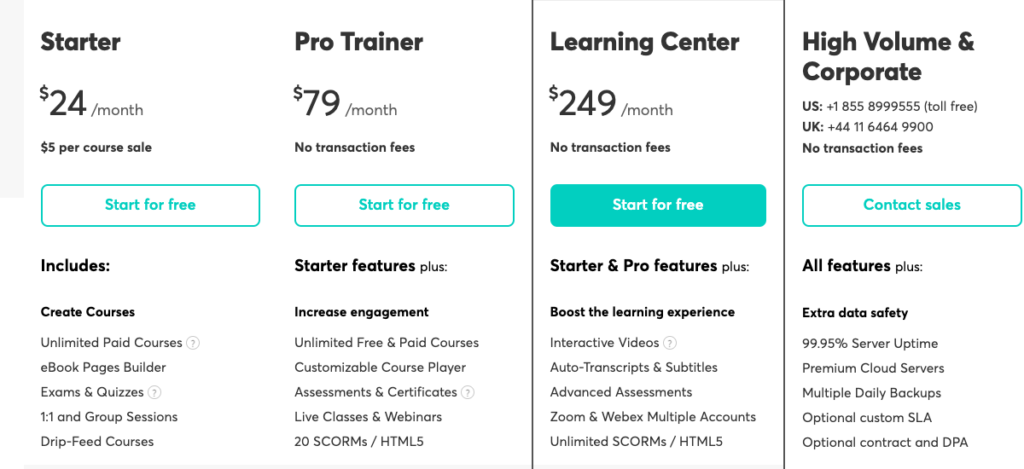
Learnworlds offers four plans for course creators: Starter, Pro Trainer, Learning Center and High Volume & Corporate. Here is a summary of what each plan includes:
Starter: $29 per month (billed annually) or $39 per month (billed monthly)
- 1 admin
- Unlimited paid courses
- Unlimited students
- Custom domain
- 4 payment gateways
- Coupons
- Email notifications
- Basic integrations
Pro Trainer: $99 per month (billed annually) or $129 per month (billed monthly)
- Everything in Starter plus:
- 5 admins
- Unlimited courses
- Customizable checkout page
- Subscriptions
- Installments
- Memberships
- Bundles
- Blog
- Affiliate management
- Zapier integration
- Advanced integrations
Learning Center: $299 per month (billed annually) or $399 per month (billed monthly)
- Everything in Pro Trainer plus:
- 20 admins
- White-labeling
- Interactive video
- Copyright protection
- School community
- Custom iOS & Android app (extra cost)
- Premium integrations
High Volume & Corporate: Custom pricing
- Everything in Learning Center plus:
- Unlimited admins
- Dedicated account manager
- Priority support
- Custom development
Overall Impressions
Learnworlds is a powerful online course platform that offers a lot of features and flexibility for course creators. It is ideal for anyone who wants to create engaging and interactive courses that stand out from the crowd. It is also suitable for anyone who wants to create a professional and branded course website and landing pages. However, Learnworlds can be pricey and may not fit everyone’s budget. It also does not have a free plan or a free trial, which can be a drawback for some people. Overall, Learnworlds is a great option for course creators who are looking for a high-quality and feature-rich online course platform in 2023.
Skool
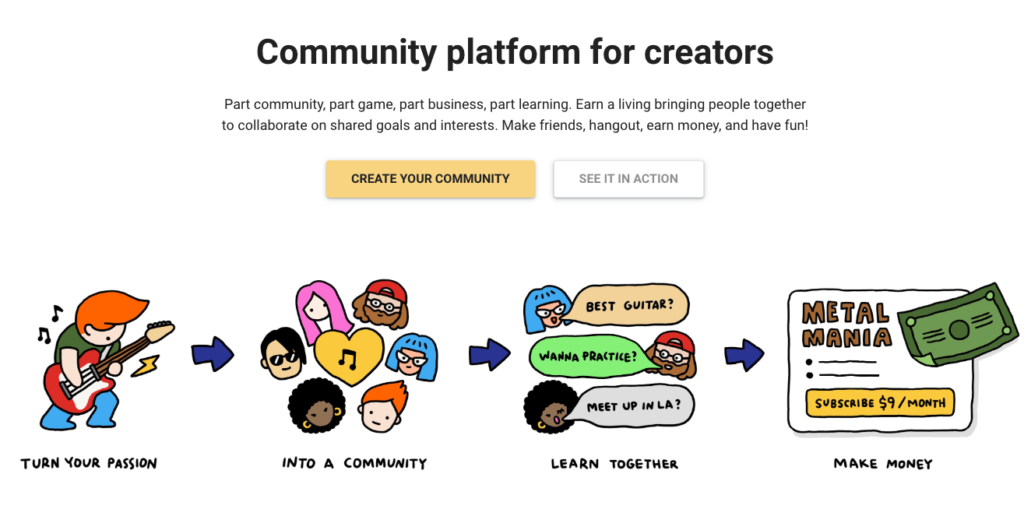
Online learning has become more popular and accessible than ever, thanks to platforms like Skool. Skool is a web-based service that allows anyone to create and join courses on various topics, from languages to coding to art:
Key Features
- Offers a variety of courses for different levels and interests, taught by qualified instructors or experts in their fields. You can browse the catalog by category, rating, difficulty, or popularity.
- Lets you create your own courses using its easy-to-use editor. You can upload videos, audio, images, text, quizzes, assignments, and more. You can also set your own price, schedule, and enrollment limit for your courses.
- Social aspect that allows you to interact with other learners and instructors. You can join live sessions, chat rooms, forums, and groups. You can also share your progress, feedback, and achievements with others.
- Uses artificial intelligence (AI) to personalize your learning experience. It recommends courses based on your preferences, goals, and performance. It also adapts the content and pace of the courses to suit your needs and level.
+
Pros:
- Convenient, flexible, affordable, and engaging
- Learn at your own pace and place
- Choose from a wide range of courses, and connect with a global community of learners and instructors.
–
Cons:
- Requires a stable internet connection and a compatible device to access the platform
- May not provide the same level of quality, accreditation, or support as some traditional or offline courses
- May also pose some challenges for self-motivated and disciplined learning
Plans and Pricing
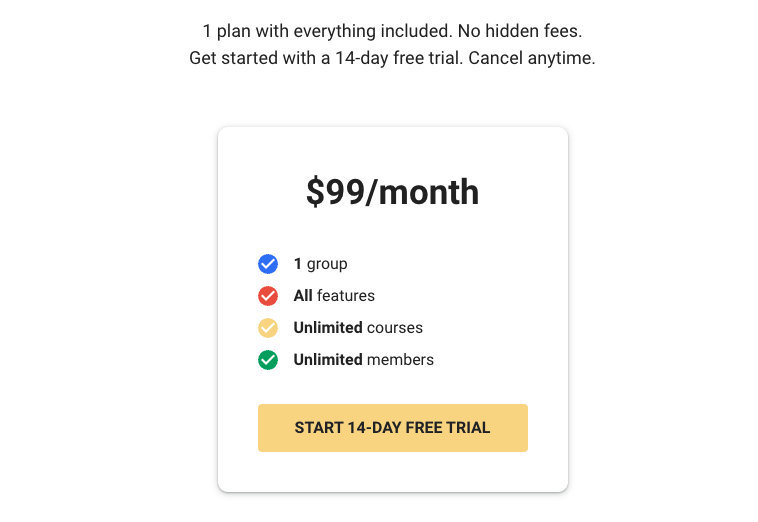
Skool has three plans for learners, Basic, Premium, and Unlimited:
- The Basic plan is free and allows you to access up to 10 courses per month.
- The Premium plan costs $9.99 per month and gives you unlimited access to all courses and features.
- The Unlimited plan costs $99.99 per year and offers the same benefits as the Premium plan plus some exclusive perks such as discounts, certificates, and priority support.
Skool also has two plans for instructors: Starter and Pro.
- The Starter plan is free and lets you create up to 5 courses with up to 50 students each.
- The Pro plan costs $19.99 per month and allows you to create unlimited courses with unlimited students. You also get to keep 90% of the revenue from your courses (after deducting payment processing fees).
Overall Impressions
Skool is a great platform for online learning that offers a lot of value for both learners and instructors. It has a user-friendly interface, a diverse catalog of courses, a supportive community, and a smart learning system. It is suitable for anyone who wants to learn something new or share their knowledge with others.
Skool is not perfect though. It still has some room for improvement in terms of quality assurance, technical support, accessibility, and recognition. It may not be able to replace or replicate some aspects of traditional or offline learning. It may also require some self-discipline and motivation from the users.
Overall, Skool is one of the leading online learning platforms in 2023 that offers a lot of benefits for both learners and instructors. It is convenient, flexible, affordable, and engaging. However, it also has some limitations and challenges that users should be aware of. If you are interested in trying out Skool, you can sign up for a free account or a trial period.
Podia
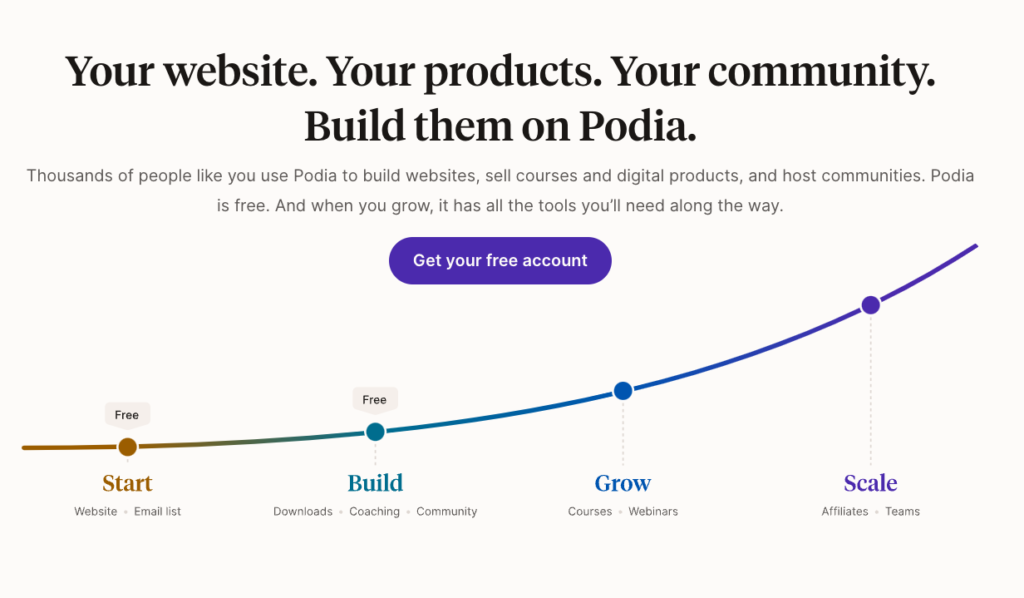
If you are an online creator looking for a platform to sell your digital products, courses, memberships, or webinars, you might have heard of Podia. Podia is a popular online platform that allows you to create, host, and sell your content without any technical hassle. But is it worth it in 2023?
Key Features
- Easy and intuitive interface: Podia has a simple and user-friendly interface that lets you create and customize your storefront, products, and pages with ease. You can use drag-and-drop elements, pre-made templates, or code your own design. You can also preview your changes in real-time and see how they look on different devices.
- Unlimited everything: Podia does not limit you on the number of products, customers, sales, or bandwidth you can have. You can create and sell as many digital products, courses, memberships, or webinars as you want, without worrying about any extra fees or charges.
- Powerful marketing tools: Podia has a built-in email marketing tool that lets you send newsletters, broadcasts, and automated campaigns to your subscribers. You can also create landing pages, sales pages, thank-you pages, and upsell pages to boost your conversions. Podia also integrates with popular tools like Zapier, Mailchimp, ConvertKit, Google Analytics, Facebook Pixel, and more.
- Excellent customer support: Podia has a friendly and responsive customer support team that is available 24/7 via email or live chat. They also have a comprehensive knowledge base, blog, podcast, and video tutorials to help you get started and grow your online business.
- No transaction fees: Podia does not charge you any transaction fees on your sales. You only pay the monthly or annual subscription fee for the plan you choose. You can also use your own domain name and branding for your storefront and products.
+
Pros:
- Easy to use and set up. You don’t need any technical skills or experience to create and sell your content on Podia.
- Offers unlimited everything. You can create and sell as many products as you want, without any restrictions or extra fees.
- Powerful marketing tools. You can use Podia’s email marketing tool, landing pages, upsell pages, and integrations to grow your audience and sales.
- Excellent customer support. You can get help from Podia’s support team anytime via email or live chat. They are friendly, helpful, and fast.
- Does not charge transaction fees. You keep 100% of your revenue from your sales on Podia.
–
Cons:
- Does not have a free plan or a free trial. You have to pay for a monthly or annual subscription to use Podia.
- Does not have a native app for mobile devices. You can access Podia’s website on your smartphone or tablet, but it is not optimized for mobile viewing or creation.
- Does not have advanced features for course creation. You can create courses on Podia using videos, audio files, PDFs, quizzes, and downloads, but you cannot add interactive elements like assignments, certificates, or progress tracking.
- Does not have a community feature for memberships. You can create memberships on Podia using posts, comments, and messages, but you cannot create forums or groups for your members.
Plans and Pricing
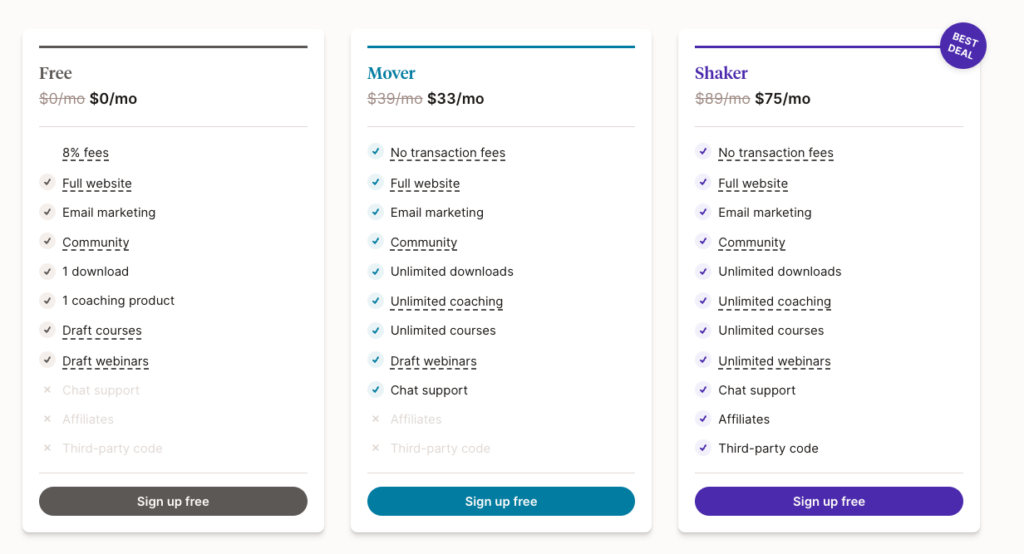
Podia has two plans to choose from: Mover and Shaker. Here is a comparison of the features and prices of each plan:
| Feature | Mover | Shaker |
|---|---|---|
| Price (monthly) | $39 | $79 |
| Price (annual) | $390 | $790 |
| Products (digital downloads, courses) | Unlimited | Unlimited |
| Customers | Unlimited | Unlimited |
| Sales | Unlimited | Unlimited |
| Bandwidth | Unlimited | Unlimited |
| Email marketing | Unlimited | Unlimited |
| Messaging | Unlimited | Unlimited |
| Memberships | Unlimited | Unlimited |
| Webinars | Unlimited | Unlimited |
| Custom domain | Yes | Yes |
| Embeddable buy buttons | Yes | Yes |
| Affiliate marketing | No | Yes |
| Third-party integrations | No | Yes |
| Free migration | No | Yes |
As you can see, the main differences between the two plans are the availability of affiliate marketing, third-party integrations, and free migration. If you want to use these features, you will have to opt for the Shaker plan. Otherwise, the Mover plan should be enough for most online creators.
Overall Impressions
Podia is a great platform for online creators who want to sell their digital products, courses, memberships, or webinars. It is easy to use, offers unlimited everything, has powerful marketing tools, and does not charge transaction fees. It also has excellent customer support and a loyal community of users.
However, Podia is not perfect. It does not have a free plan or a free trial, does not have a native app for mobile devices, does not have advanced features for course creation, and does not have a community feature for memberships. It also has a relatively high price compared to some of its competitors.
Therefore, Podia is best suited for online creators who are looking for a simple and reliable platform to sell their content, without needing too much customization or functionality. If you are one of them, you can sign up for Podia here and start creating and selling your content today.
Mighty Networks

Mighty Networks is a platform that allows you to create and manage your own online community, courses, events, memberships, and content. It aims to help you build a loyal and engaged audience around your niche, passion, or expertise. But is it the right choice for you?
Mighty Networks offers a variety of features to help you create and grow your online community. Some of the main ones are:
Key Features
- Customizable branding: You can choose your own domain name, logo, colors, fonts, and layout for your network. You can also create sub-groups within your network for different topics, interests, or levels of access.
- Mobile app: You can access your network from any device using the Mighty Networks app, which is available for iOS and Android. You can also create your own branded app for your network with the Mighty Pro plan.
- Courses and events: You can create and sell online courses and events within your network. You can use video, audio, text, quizzes, polls, and assignments to deliver your content. You can also set up recurring payments, coupons, bundles, and memberships for your courses and events.
- Content creation: You can create and share various types of content with your network members, such as articles, podcasts, videos, polls, questions, and more. You can also enable comments, reactions, and notifications to encourage engagement and feedback.
- Analytics and insights: You can track and measure the performance of your network using the analytics dashboard. You can see metrics such as members, activity, revenue, retention, engagement, and growth. You can also use the insights feature to discover trends, patterns, and opportunities within your network.
+
Pros:
- Easy to use: Mighty Networks has a user-friendly interface that makes it easy to set up and manage your network. You don’t need any coding or design skills to create a professional-looking network
- All-in-one platform: Mighty Networks allows you to host everything in one place: your community, courses, events, content, and payments. You don’t need to integrate with multiple tools or platforms to run your online business
- Flexible and scalable: Mighty Networks gives you the freedom and control to customize your network according to your needs and goals. You can also expand your network as you grow by adding more features, members, or sub-groups
- Supportive community: Mighty Networks has a supportive community of creators who are willing to share their experiences, tips, and best practices. You can also join the Mighty Hosts Network, which is a network for network hosts where you can learn from experts, get feedback, and access exclusive resources.
–
Cons:
- Limited integrations: Mighty Networks does not integrate with many third-party tools or platforms that you may want to use for your online business. For example, you cannot integrate with email marketing services like Mailchimp or ConvertKit or with webinar platforms like Zoom or WebinarJam.
- High pricing: Mighty Networks can be quite expensive compared to other online community platforms. The cheapest plan starts at $28 per month (billed annually) and only allows you to have up to 100 members. The most expensive plan costs $999 per month (billed annually) and allows you to have unlimited members and features.
- No free trial: Mighty Networks does not offer a free trial for any of its plans. You can only test the platform by creating a free network with limited features and members.
Plans and Pricing
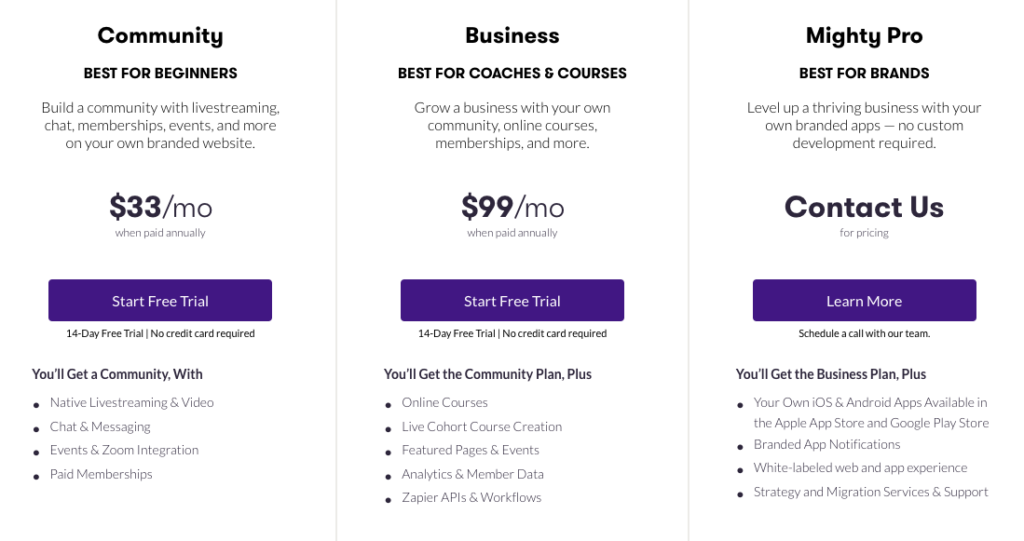
Mighty Networks offers four plans for different levels of needs and budgets:
- Free: This plan allows you to create a free network with up to 10 members. You can access basic features such as branding, content creation, and analytics. However, you cannot sell courses or events, create sub-groups, or use custom domains.
- Creator: This plan costs $28 per month (billed annually) or $35 per month (billed monthly). It allows you to have up to 100 members and access more features such as courses, events,
sub-groups, and custom domains. You can also sell courses and events with a 5% transaction fee. - Business: This plan costs $98 per month (billed annually) or $125 per month (billed monthly). It allows you to have up to 1000 members and access all the features of the Creator plan plus more such as memberships, bundles, coupons, and branded app. You can also sell courses and events
with a 3% transaction fee. - Mighty Pro: This plan costs $999 per month (billed annually) or $1250 per month (billed monthly). It allows you to have unlimited members and access all the features of the Business plan plus more such as multiple networks, custom app store listing, and dedicated account manager. You can also sell courses and events with a 2% transaction fee.
Overall Impressions
Mighty Networks is a powerful and versatile platform for online community builders who want to create and monetize their own network. It offers a lot of features and benefits that can help you attract and engage your audience. However, it also has some limitations and drawbacks that may not suit everyone’s needs and preferences. Therefore, you should weigh the pros and cons carefully before deciding to use Mighty Networks for your online business.
Thinkific

Thinkific is one of the most popular online course platforms in 2023. It has over 50,000 course creators who have sold more than $650 million worth of courses. Thinkific offers a powerful and user-friendly platform that allows you to create and sell high-quality online courses with ease.
Key Features
- Drag-and-drop course builder
- Unlimited courses and students
- Custom domain name
- Full branding control
- Multiple content types
- Quizzes and surveys
- Certificates of completion
- Student progress tracking
- Email notifications
- Coupons and promotions
- Payment plans and subscriptions
- Affiliate marketing
- Zapier integration
- Advanced analytics
- Data exports
- SSL security
+
Pros:
- Easy to use and intuitive interface
- Flexible and customizable design options
- No transaction fees on any plan
- Free plan available for up to 3 courses
- 30-day money-back guarantee
–
Cons:
- Limited community features
- No live chat or phone support
- No built-in email marketing tools
Plans and Pricing
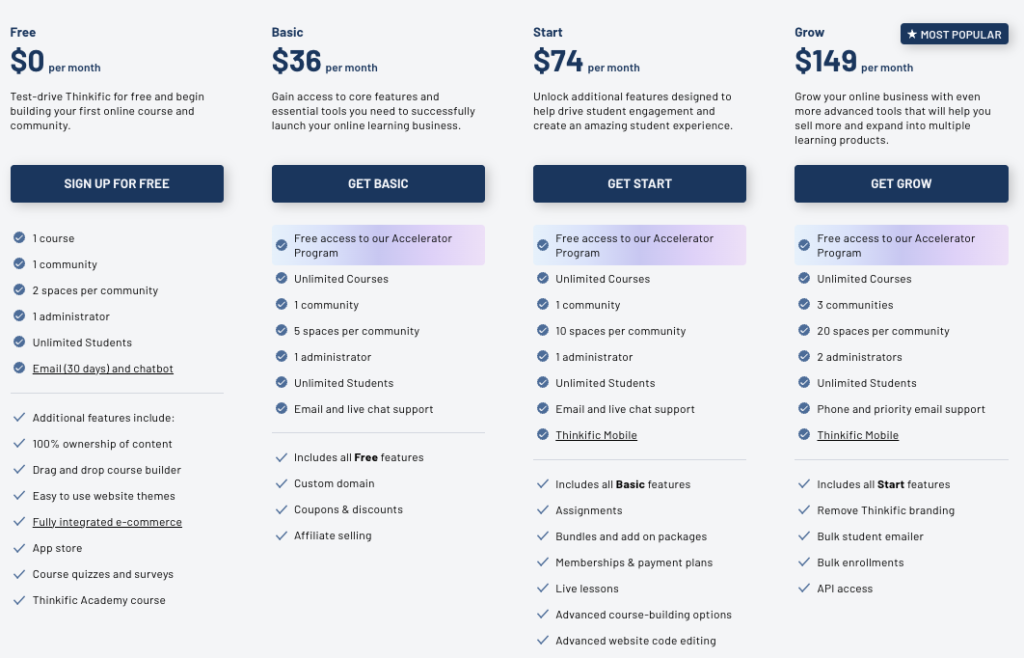
Thinkific offers four pricing plans:
- Free: $0/month for up to 3 courses
- Basic: $49/month for unlimited courses
- Pro: $99/month for unlimited courses plus advanced features
- Premier: $499/month for unlimited courses plus priority support
You can save 20% if you pay annually. Thinkific also offers a 30-day free trial for all plans.
Overall Conclusion
Thinkific is a great online course platform for beginners and experts alike. It offers a simple and powerful way to create and sell professional online courses without any technical hassle. It also has a generous free plan and a reasonable pricing structure that lets you keep all your revenue.
Kajabi
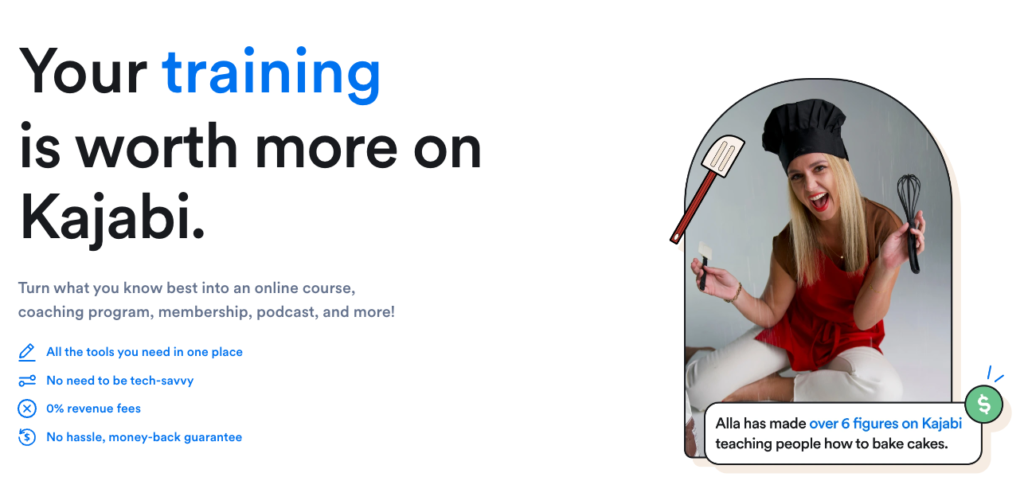
Kajabi is another leading online course platform in 2023. It has over 40,000 course creators who have generated more than $1.5 billion in sales. Kajabi is an all-in-one platform that allows you to create, market, and sell online courses and memberships with ease.
Key Features
- Drag-and-drop course builder
- Unlimited courses and students
- Custom domain name
- Full branding control
- Multiple content types
- Quizzes and assessments
- Certificates of completion
- Student progress tracking
- Email notifications
- Coupons and discounts
- Payment plans and subscriptions
- Affiliate marketing
- Zapier integration
- Advanced analytics
- Data exports
- SSL security
+
Pros:
- Comprehensive and integrated platform
- Beautiful and responsive design options
- Powerful and built-in marketing tools
- 24/7 live chat and phone support
–
Cons:
- Expensive pricing plans
- No free plan or trial available
- Limited customization options
Plans and Pricing
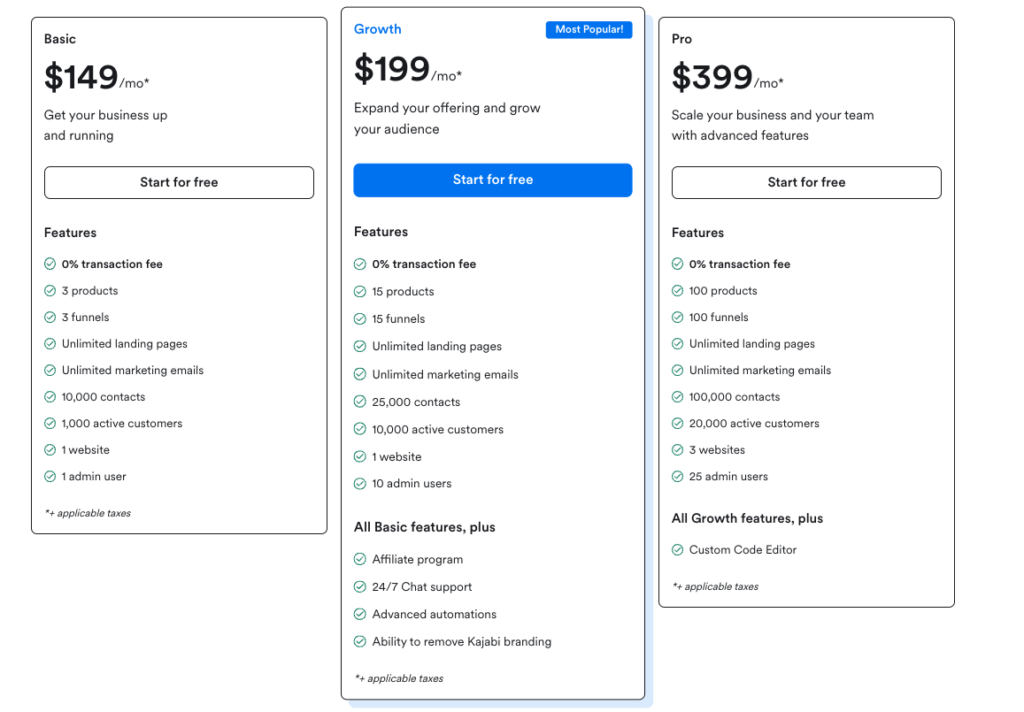
Kajabi offers three pricing plans:
- Basic: $149/month for up to 3 products and 10,000 contacts
- Growth: $199/month for up to 15 products and 25,000 contacts
- Pro: $399/month for up to 100 products and 100,000 contacts
You can save 20% if you pay annually. Kajabi does not offer a free plan or a free trial, but it does offer a 30-day money-back guarantee.
Overall Conclusion
Kajabi is a premium online course platform for serious course creators who want to scale their online business. It offers a comprehensive and integrated solution that covers everything from course creation to marketing and sales. It also has a high-quality customer service and support team.
Teachable

Teachable is another popular online course platform in 2023. It has over 100,000 course creators who have sold more than $500 million worth of courses. Teachable offers a simple and user-friendly platform that allows you to create and sell online courses with ease.
Key Features
- Drag-and-drop course builder
- Unlimited courses and students
- Custom domain name
- Full branding control
- Multiple content types
- Quizzes and feedback forms
- Certificates of completion
- Student progress tracking
- Email notifications
- Coupons and promotions
- Payment plans and subscriptions
- Affiliate marketing
- Zapier integration
- Basic analytics
- Data exports
- SSL security
+
Pros:
- Easy to use and intuitive interface
- Flexible and customizable design options
- No technical skills required
- Free plan available for up to 10 students
–
Cons:
- Transaction fees on lower plans
- Limited community features
- No live chat or phone support
Plans and Pricing
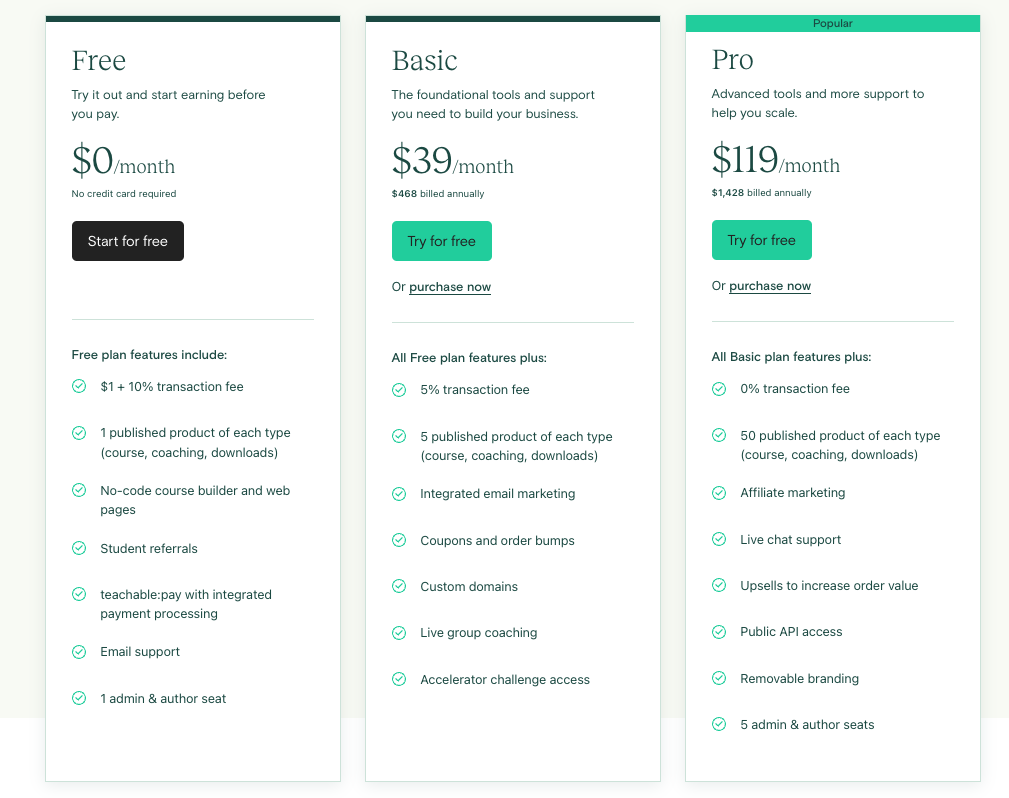
Teachable offers four pricing plans:
- Free: $0/month for up to 10 students
- Basic: $39/month for unlimited students plus 5% transaction fees
- Pro: $119/month for unlimited students plus no transaction fees
- Business: $299/month for unlimited students plus priority support
You can save 20% if you pay annually. Teachable also offers a 14-day free trial for all plans.
Overall Conclusion
Teachable is a great online course platform for beginners and hobbyists who want to create and sell online courses without any technical hassle. It offers a simple and user-friendly way to create and sell online courses with minimal investment. It also has a generous free plan and a reasonable pricing structure that lets you grow your revenue.
Best Online Learning Platforms
Online learning has become more popular and accessible than ever, thanks to the advances in technology and the changing needs of learners. Whether you want to learn a new skill, earn a degree, or pursue a hobby, there is an online platform that can cater to your goals and preferences. But with so many options available, how do you choose the best one for you? Here are some of the factors to consider when comparing different online learning platforms:
- Content quality and variety: You want to learn from high-quality courses that are relevant, engaging, and up-to-date. You also want to have a wide range of topics and levels to choose from, so you can find something that suits your interests and needs.
- Instructor expertise and feedback: You want to learn from instructors who are experts in their fields and who can provide clear explanations, examples, and guidance. You also want to receive timely and constructive feedback on your progress and performance, so you can improve your skills and knowledge.
- Platform features and usability: You want to use a platform that is easy to navigate, user-friendly, and compatible with your devices. You also want to have access to features that enhance your learning experience, such as interactive quizzes, live sessions, peer collaboration, certificates, etc.
- Price and value: You want to get the best value for your money, so you need to compare the prices and benefits of different platforms. You also need to consider your budget and how much you are willing to invest in your learning.
Based on these criteria, here are some of the best online learning platforms in 2023 that you can check out:
- Coursera:🥇 is one of the most popular and reputable online learning platforms, offering thousands of courses from top universities and organizations around the world. You can learn anything from data science and business to arts and humanities, at various levels and formats. You can also earn certificates and degrees from accredited institutions, as well as professional certificates that can boost your career prospects.
- Udemy:🥈is another leading online learning platform, with over 150,000 courses on a wide range of topics. You can learn from instructors who are passionate and experienced in their fields, and who create their own courses based on their expertise and insights. You can also access courses anytime, anywhere, and at your own pace, with lifetime access and updates.
- Skillshare:🥉is an online learning community that focuses on creative skills, such as design, photography, writing, etc. You can learn from thousands of classes taught by experts and professionals in their fields, as well as from other learners who share their projects and feedback. You can also join live classes, workshops, and challenges that can help you hone your skills and network with others.
- edX: is a nonprofit online learning platform that partners with over 160 universities and organizations around the world. You can access high-quality courses on subjects such as computer science, engineering, humanities, etc., as well as microcredentials and degrees that are recognized by employers and academic institutions. You can also learn at your own pace or follow a structured schedule, depending on your preferences.
- Khan Academy: is a free online learning platform that aims to provide a world-class education for anyone, anywhere. You can learn from over 10,000 videos and exercises on subjects such as math, science, history, etc., as well as test prep for exams such as SAT, GMAT, etc. You can also track your progress and earn badges and points as you learn.
Here’s hoping this post finds you safe, healthy, and ready to take on distance and/or online learning with all your might! Good luck and best wishes for your future endeavors.
—
Disclosure: Please note that we may receive affiliate compensation for some of the links below, at no expense to you, should you decide to purchase a paid plan. This blog does not provide financial advice, it is purely for entertainment and fun.





